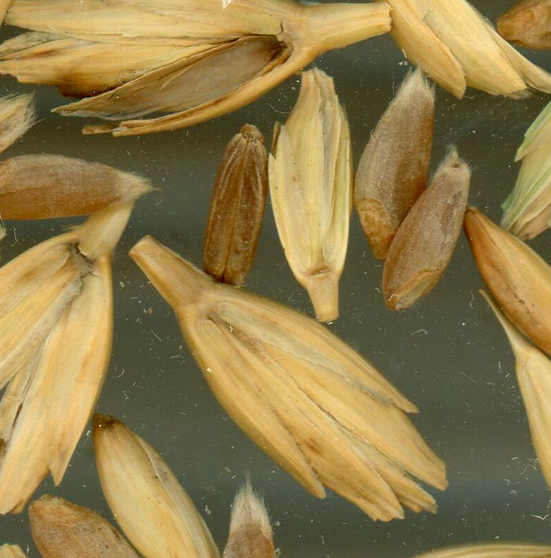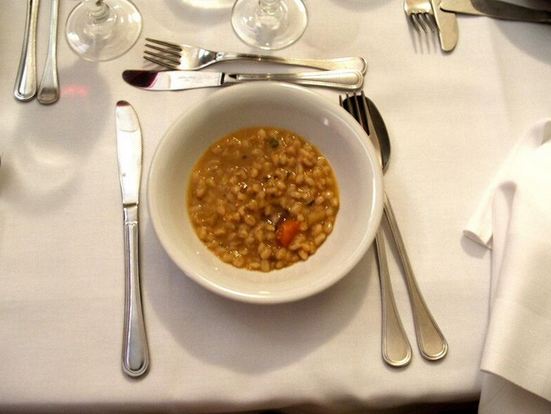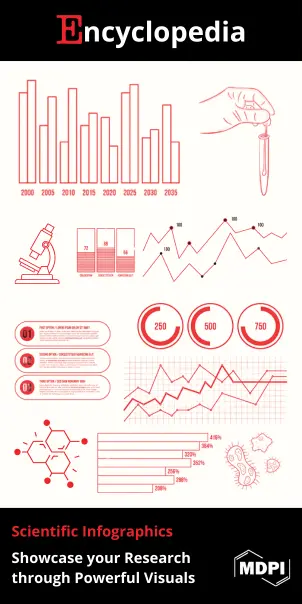
| Version | Summary | Created by | Modification | Content Size | Created at | Operation |
|---|---|---|---|---|---|---|
| 1 | Beatrix Zheng | -- | 1572 | 2022-11-07 01:51:14 |
Video Upload Options
Emmer wheat or hulled wheat is a type of awned wheat. Emmer is a tetraploid (2n = 4x = 28 chromosomes). The domesticated types are Triticum turgidum subsp. dicoccum and Triticum turgidum conv. durum. The wild plant is called Triticum turgidum subsp. dicoccoides. The principal difference between the wild and the domestic is that the ripened seed head of the wild plant shatters and scatters the seed onto the ground, while in the domesticated emmer the seed head remains intact, thus making it easier for humans to harvest the grain. Along with einkorn wheat, emmer was one of the first crops domesticated in the Near East. It was widely cultivated in the ancient world, but is now a relict crop in mountainous regions of Europe and Asia. Emmer is considered a type of farro food especially in Italy.
1. Taxonomy
Strong similarities in morphology and genetics show that wild emmer (Triticum dicoccoides Koern.) is the wild ancestor and a crop wild relative of domesticated emmer. Because wild and domesticated emmer are interfertile with other tetraploid wheats, some taxonomists consider all tetraploid wheats to belong to one species, T. turgidum. Under this scheme, the two forms are recognized at subspecies level, thus T. turgidum subsp. dicoccoides and T. turgidum subsp. dicoccum. Either naming system is equally valid; the latter lays more emphasis on genetic similarities.
For a wider discussion, see Wheat and Wheat taxonomy
1.1. Wild Emmer
Wild emmer grows wild in the Near East. It is a tetraploid wheat formed by the hybridization of two diploid wild grasses, Triticum urartu, closely related to wild einkorn (T. boeoticum), and an as yet unidentified Aegilops species related to A. searsii or A. speltoides.
2. Morphology

Like einkorn and spelt wheats, emmer is a hulled wheat. In other words, it has strong glumes (husks) that enclose the grains, and a semibrittle rachis. On threshing, a hulled wheat spike breaks up into spikelets. These require milling or pounding to release the grains from the glumes.
Wild emmer wheat spikelets effectively self-cultivate by propelling themselves mechanically into soils with their awns. During a period of increased humidity during the night, the awns of the spikelet become erect and draw together, and in the process push the grain into the soil. During the daytime, the humidity drops and the awns slacken back again; however, fine silica hairs on the awns act as hooks in the soil and prevent the spikelets from backing out. During the course of alternating stages of daytime drying and nighttime humidity, the awns' pumping movements, which resemble a swimming frog kick, will drill the spikelet an inch (25.4 mm) or more into the soil.[1]
3. Etymology
First use: 1908
Origin: species of wheat, from German Emmer, variant of Amelkorn, from amel, "starch", from Latin amylum.[2]
4. History
Wild emmer is native to the Fertile Crescent of the Middle East, growing in the grass and woodland of hill country from modern-day Israel to Iran. The origin of wild emmer has been suggested, without universal agreement among scholars, to be the Karaca Dag mountain region of southeastern Turkey. In 1906, Aaron Aaronsohn's discovery of wild emmer wheat growing in Rosh Pinna (Israel) created a stir in the botanical world.[3] Emmer wheat has been found in archaeological excavations and ancient tombs. Emmer was collected from the wild and eaten by hunter gatherers for thousands of years before its domestication. Grains of wild emmer discovered at Ohalo II had a radiocarbon dating of 17,000 BC and at the Pre-Pottery Neolithic A (PPNA) site of Netiv Hagdud are 10,000–9,400 years old.[4]
The location of the earliest site of emmer domestication is still unclear and under debate.[5] Some of the earliest sites with possible indirect evidence for emmer domestication during the Early Pre-Pottery Neolithic B include Tell Aswad, Çayönü, Cafer Höyük, Aşıklı Höyük, Kissonerga-Mylouthkia and Shillourokambos.[5] Definitive evidence for the full domestication of emmer wheat is not found until the Middle Pre-Pottery Neolithic B (10,200 to 9,500 BP), at sites such as Beidha, Tell Ghoraifé, Tell es-Sultan (Jericho), Abu Hureyra, Tell Halula, Tell Aswad and Cafer Höyük.[5]
Emmer is found in a large number of Neolithic sites scattered around the fertile crescent. From its earliest days of cultivation, emmer was a more prominent crop than its cereal contemporaries and competitors, einkorn wheat and barley.[6] Small quantities of emmer are present during Period 1 at Mehrgharh on the Indian subcontinent, showing that emmer was already cultivated there by 7000–5000 BC.[7]
In the Near East, in southern Mesopotamia in particular, cultivation of emmer wheat began to decline in the Early Bronze Age, from about 3000 BC, and barley became the standard cereal crop. This has been related to increased salinization of irrigated alluvial soils, of which barley is more tolerant,[8] although this study has been challenged.[9] Emmer had a special place in ancient Egypt, where it was the main wheat cultivated in Pharaonic times, although cultivated einkorn wheat was grown in great abundance during the Third Dynasty, and large quantities of it were found preserved, along with cultivated emmer wheat and barleys, in the subterranean chambers beneath the Step Pyramid at Saqqara.[10] Neighbouring countries also cultivated einkorn, durum and common wheat.[11] In the absence of any obvious functional explanation, the greater prevalence of emmer wheat in the diet of ancient Egypt may simply reflect a marked culinary or cultural preference, or may reflect growing conditions having changed after the Third Dynasty. Emmer and barley were the primary ingredients in ancient Egyptian bread and beer. Emmer recovered from the Phoenician settlement at Volubilis[12] (in present-day Morocco) has been dated to the middle of the first millennium BC.
Emmer wheat may be one of the grains mentioned in ancient rabbinic literature as one of the five grains to be used by Jews during Passover as matzah (that is, kept from leavening, even accidental).[13] However, this depends on the meaning of the Hebrew term shibboleth shu'al, which is uncertain and debated. The matter is further complicated by the cultivation of spelt (Heb. kusemet, Aramaic kusmin) in Israel of Biblical times and onward[14] (spelt is easily confused with emmer). However, it is fairly certain that spelt did not grow in ancient Israel, and emmer was probably a significant crop until the end of the Iron Age. Likewise, references to emmer in Greek and Latin texts are traditionally translated as "spelt," even though spelt was not common in the Classical world until very late in its history.
In northeastern Europe, emmer (in addition to einkorn and barley) was one of the most important cereal species and this importance can be seen to increase from 3400 BC onward. Pliny the Elder, notes that although emmer was called far in his time formerly it was called adoreum (or "glory"), providing an etymology explaining that emmer had been held in glory (N.H. 18.3), and later in the same book he describes its role in sacrifices.
5. Cultivation
Today emmer is primarily a relict crop in mountainous areas. Its value lies in its ability to give good yields on poor soils, and its resistance to fungal diseases such as stem rust that are prevalent in wet areas. Emmer is grown in Armenia, Morocco, Spain (Asturias), the Carpathian mountains on the border of the Czech and Slovak republics, Albania, Turkey, Switzerland, Germany, Greece and Italy. It is also grown in the U.S. as a specialty product. A traditional food plant in Ethiopia, this relatively little-known grain has potential to improve nutrition, boost food security, foster rural development and support sustainable landcare.[15]
In Italy, uniquely, emmer cultivation is well established and even expanding. In the mountainous Garfagnana area of Tuscany emmer (known as farro) is grown by farmers as an IGP (Indicazione Geografica Protetta) product, with its geographic identity protected by law. Production is certified by a co-operative body, the Consorzio Produttori Farro della Garfagnana. IGP-certified farro is widely available in health food shops across Europe, and even in some British supermarkets. The demand for Italian farro has led to competition from non-certified farro, grown in lowland areas and often consisting of a different wheat species, spelt (Triticum spelta).
6. Food Uses

Emmer's main use is as a human food, though it is also used for animal feed. Ethnographic evidence from Turkey and other emmer-growing areas suggests that emmer makes good bread (judged by the taste and texture standards of traditional bread), and this is supported by evidence of its widespread consumption as bread in ancient Egypt.[16] Emmer bread is available in the Netherlands and Switzerland.[17]
In Italy, whole emmer grains can be easily found in most supermarkets and groceries, emmer bread (pane di farro) can be found in bakeries in some areas, and emmer has traditionally been consumed in Tuscany as whole grain in soup. Emmer has also been used in beer production.[18]
The largest Dutch supermarket chain in the Netherlands, Albert Heijn, sells emmer bread as part of their luxury bread line.
In parts of India, emmer wheat (खपली गहू in Maharashtra) is grown as a drought- and stress-resistant wheat variety with some work ongoing to improve yields, as a result of increased interest in this variety due to possible value for diabetics.[19]
As with all varieties and hybrids of wheat,[20] emmer is unsuitable for people with gluten-related disorders, such as celiac disease, non-celiac gluten sensitivity and wheat allergy sufferers, among others.[21][22]
References
- Elbaum, Rivka; Zaltzman, Liron; Burgert, Ingo; Fratzl, Peter (2007). "The Role of Wheat Awns in the Seed Dispersal Unit". Science 316 (5826): 884–886. doi:10.1126/science.1140097. PMID 17495170. Bibcode: 2007Sci...316..884E. https://dx.doi.org/10.1126%2Fscience.1140097
- "Online Etymology Dictionary". http://www.etymonline.com/index.php?term=emmer. Retrieved 2011-08-10.
- "Archived copy". Archived from the original on 2009-01-07. https://web.archive.org/web/20090107154334/http://www.jafi.org.il/education/100/PEOPLE/bios/aron.html. Retrieved 2008-10-05.
- null
- Weide, Alexander (2015). "On the Identification of Domesticated Emmer Wheat, Triticum turgidum subsp. dicoccum (Poaceae), in the Aceramic Neolithic of the Fertile Crescent". Archäologische Informationen (de).
- Weiss and Zohary, pp. S240-S242
- Possehl, Gregory. "The Indus Civilization: An Introduction to Environmental, Subsistence, and Cultural History: (2003)
- Jacobsen & Adams 1958
- Powell, M. A. (1985) Salt, seed, and yields in Sumerian agriculture. A critique of the theory of progressive salinization. Zeitschrift für Assyriologie und Vorderasiatische Archäologie 75, 7-38.
- Jean-Phillipe Lauer, Laurent Taeckholm and E. Aberg, 'Les Plantes Decouvertes dans les Souterrains de l'Enceinte du Roi Zoser a Saqqarah' in Bulletin de l'Institut d'Egypte, Vol. XXXII, 1949-50, pp. 121–157, and see Plate IV for photo of ears of both wheats recovered from beneath the pyramid.
- Zohary & Hopf 2000, pp. 50f
- C. Michael Hogan. 2008. Volubilis: Ancient settlement in Morocco, The Megalithic Portal, ed. Andy Burnham http://www.megalithic.co.uk/article.php?sid=14906
- Mishnah, Tractate Pesahim 2:5
- See Isaiah 28:25 and Mishnah loc. cit.
- National Research Council (1996-02-14). "Other Cultivated Grains". Lost Crops of Africa: Volume I: Grains. Lost Crops of Africa. 1. National Academies Press. ISBN 978-0-309-04990-0. http://books.nap.edu/openbook.php?record_id=2305&page=239. Retrieved 2008-07-18.
- Hulled wheats. Proceedings of the First International Workshop on Hulled Wheats. Promoting the conservation and use of underutilized and neglected crops 4. Edited by S. Padulosi, K. Hammer, and J. Heller, 1996. Rome: International Plant Genetic Resources Institute. http://www.bioversityinternational.com/Publications/pubfile.asp?ID_PUB=54
- "Renaissance alter Brotgetreidesorten - swissinfo" (in de). Swissinfo.ch. http://www.swissinfo.ch/ger/swissinfo.html?siteSect=601&sid=6120540. Retrieved 2010-11-13.
- Samuel, Delwen. 1996. Archeology of Ancient Egyptian Beer. Journal of the American Society of Brewing Chemists 54(1): 3-12
- Urs, Anil. "Medicinal traits found in 'Khapli' wheat" (in en). https://www.thehindubusinessline.com/economy/agri-business/medicinal-traits-found-in-lsquokhapli-wheat/article20100642.ece1.
- "Nonceliac gluten sensitivity". Gastroenterology 148 (6): 1195–204. May 2015. doi:10.1053/j.gastro.2014.12.049. PMID 25583468. https://dx.doi.org/10.1053%2Fj.gastro.2014.12.049
- "Clinical and diagnostic aspects of gluten related disorders". World J Clin Cases 3 (3): 275–84. Mar 16, 2015. doi:10.12998/wjcc.v3.i3.275. PMID 25789300. http://www.pubmedcentral.nih.gov/articlerender.fcgi?tool=pmcentrez&artid=4360499
- "Grains in Relation to Celiac (Coeliac) Disease". Wheat.pw.usda.gov. http://wheat.pw.usda.gov/ggpages/topics/celiac.html. Retrieved 2010-11-13.




